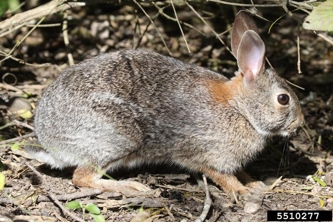Eastern Cottontail (Sylvilagus floridanus)
New England Cottontail (Sylvilagus transitionalis)

The cottontail rabbit has large hind feet, long ears, and a short, fluffy tail that resembles a cotton ball which gives it its name. Coat color can vary from reddish-brown to grayish-brown with white underparts. The nearly identical New England and eastern cottontails have a slight variation in color. Some eastern cottontails have a white, star-like shape on the forehead.
The New England Cottontail has a range from New England west to the Hudson River, the Eastern Cottontail has a much wider territory that encompasses the eastern United States, southern Canada, and eastern Mexico into Central America. There is another population that is found in Texas, New Mexico, and Arizona. Rabbits and hares are very prolific as they are considered full-grown adults by the age of three months and can have up to 6 (or more) litters per year with several kits in each litter. Only 15% of a litter generally survives the first year and then the average lifespan is two years. Birds of prey are the largest threat to a rabbit population but snakes and humans are also a threat.
Damage
Hares and rabbits will eat a wide variety of herbaceous and woody plants. A diet of bark and stems is often preferred during the colder months when much damage to gardens and orchards may occur, especially during peak population years. In the spring and summer, they develop an appetite for flowers (especially tulips) and vegetables.
Rabbit-damaged trees and shrubs are easily identified by the characteristic tooth marks left when the animals feed. Twigs are usually clipped cleanly at a 45-degree angle and bark on lower stems and branches is gnawed away, leaving parallel grooves in the wood. Rabbits are active year-round foraging mainly at dusk or evening.
Management
Since rabbits and hares are usually classified as game animals, visit the Connecticut DEEP Fish and Wildlife department for the current Connecticut Hunting and Trapping Guide. The regular hunting season in Connecticut occurs from fall into winter.
One of the most effective methods of reducing damage is to fence the animals out. A fence of chicken wire two feet high is usually sufficient to protect the garden from rabbits. Mesh size should be no more than one inch and the bottom of the fence must be tight against the ground or buried a few inches. If feral domestic rabbits or hares are the problem, the fence should be 30 – 36 inches high with the bottom 6 inches of fencing bent outward and buried 6 inches. Individual plants may be protected with cylinders of 1/4-inch mesh hardware cloth about 18 to 20 inches long. Commercial tree wraps can also be effective.
Habitat manipulation can also help reduce rabbit/hare damage. Removing briar patches, brush piles and other hiding places will reduce the overall number of animals in the area.
There are several repellents registered for rabbit and hare management. Most of these are somewhat effective if the feeding pressure is not too great. Many are labeled only for use on ornamentals.
There are lists of plants that rabbits don’t eat but that will depend on the availability of other food sources and the size of the rabbit (and deer) population in any given area.
Despite good cultural practices, pests and diseases at times may appear. Chemical control should be used only after all other methods have failed.
For questions please call toll free: 877-486-6271.
Revised by the UConn Home & Garden Education Center, 2016.